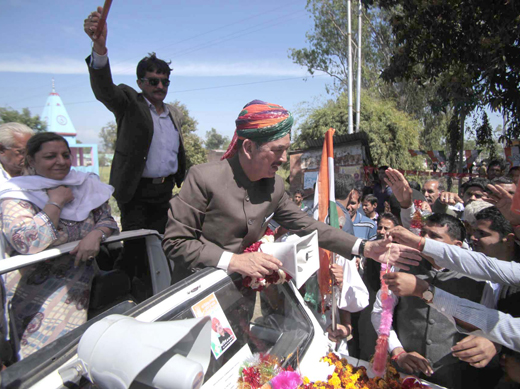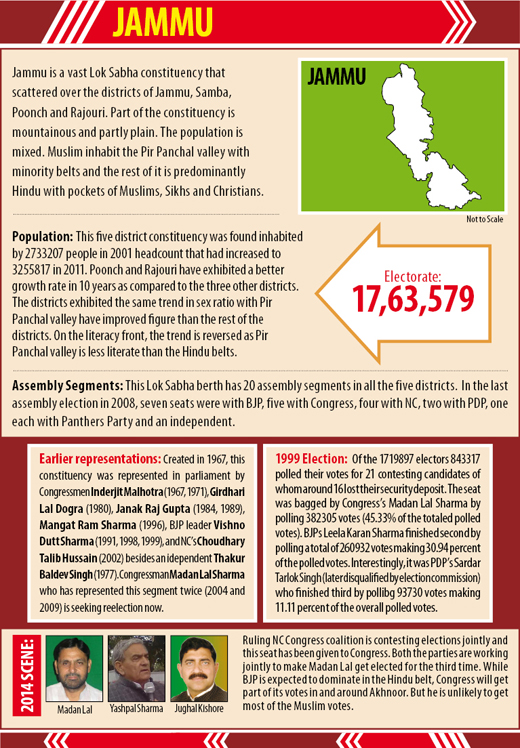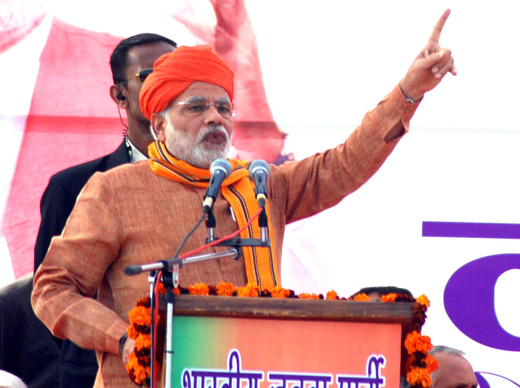Contrary to the popular discourse that Jammu Lok Sabha polls is BJP versus Congress, the election is the battle between three parties with PDP as the youngest challenger. Though not a winning bet, this party is merely filling the gap that NC voluntarily left for Congress, analyses R S Gull

For decades, the Hindu right in Jammu has been talking in two languages over the issues of development and representation. When it comes to Jammu versus Kashmir, the claims have historically been staked for every inch between the Madhopur bridge to the Chakan da Bagh. But it is the issue of Lok Sabha, they have been cursing the policy makers who have done a great injustice by mixing demographic heterogeneity of the region. It is this part of the crisis that holds the key to the results of 2014 Lok Sabha election.
While the assessment is being made on basis of the mood in the Hindu heartland comprising Jammu town and the neighbouring Samba district, nobody has been taking care of what the other part of the segment feels: the remote twin districts of Rajouri and Poonch. This is possible that these two districts may hold the key to the outcome, this time.
A general belief is that this election in this segment is BJP versus Congress. But the fact is it is a triangular contest between three Sharmas’, all Brahmins: BJPs Jugal Kishore Sharma, Congress’s Madan Lal Sharma and PDP’s Yash Pal Sharma. The NC that has once represented this segment on basis of the Pir Panchal valley is apparently missing in action because it is part of the coalition that has given this seat to Congress.
In February 2002 Bye-Poll was necessitated by the death of BJP MP Vishno Dutt Sharma. It created history of sorts because, for the first and perhaps the last time, the constituency was represented by a non-Hindu, non-Brahmin, non-Congress and non-BJP candidate – Choudhary Talib Hussain who polled 253891 votes making 34.87 percent of the total polled votes and defeated BJPs Dr Nirmal Singh who could secure only 198402 votes (27.24 percent of total polled).
 But all the three main contestants have peculiar advantages and disadvantages. Take for instance, BJP that most of the psephologists think is the possible winner of this Lok Sabha constituency. To ensure its candidate, who represents Nagrota in state assembly, record a huge victory over Congress, BJP’s prime ministerial candidate Narendra Modi flew to Jammu early this year and the party mobilized a huge gathering in the stadium. While the mood is clearly pro-Modi in the main town, the issue is whether the party can manage polling all the Hindu votes when Congress has ensured a lot of development. Besides, BJP is still not a cohesive force given the problems the party still has with Prof Chaman Lal Gupta, its most senior member in the state assembly. Even if the BJP makes most of the Hindu votes, how will it manage the winning margin from the Muslim belt? This is despite the fact that the candidate seeking replacement of Congressman in the Lok Sabha, according to Chief Minister Omar Abdullah, has a murder case pending against him.
But all the three main contestants have peculiar advantages and disadvantages. Take for instance, BJP that most of the psephologists think is the possible winner of this Lok Sabha constituency. To ensure its candidate, who represents Nagrota in state assembly, record a huge victory over Congress, BJP’s prime ministerial candidate Narendra Modi flew to Jammu early this year and the party mobilized a huge gathering in the stadium. While the mood is clearly pro-Modi in the main town, the issue is whether the party can manage polling all the Hindu votes when Congress has ensured a lot of development. Besides, BJP is still not a cohesive force given the problems the party still has with Prof Chaman Lal Gupta, its most senior member in the state assembly. Even if the BJP makes most of the Hindu votes, how will it manage the winning margin from the Muslim belt? This is despite the fact that the candidate seeking replacement of Congressman in the Lok Sabha, according to Chief Minister Omar Abdullah, has a murder case pending against him.
For Congress, the issue is completely different. Firstly, it seems not in a position to stake the claims over all the Hindu votes. Its oft-repeated plea of secularism lacks an appeal right now in the plains of Jammu. Despite that Madan Lal Sharma is in a strong footing in his Akhnor belt because his brother Sham Lal Sharma has really worked hard in the last five years. He has been accused of seeing J&K in his constituency Akhnoor’s map!
There is possibility that Sharma may lack support from his arch rival Tara Chand’s area. The two families have been at logger heads at many occasions. Supporters of Lal Singh, who represented Udhampur-Doda twice for Congress, but was denied mandate this time, are angry. They have started working against the party by openly talking against the High Command saying “of the two seats with Hindus, the party has given one to a Musalmaan (read Ghulam Nabi Azad)”.
Secondly, an issue that can trigger a larger problem for Sharma’s secular bogey is that he has ignored the Muslim belt in both his stints in the Parliament, or at least, it is being alleged. Even at one stage, the NC had desperately suggested Congress to change him, this time. After they failed to prevail upon the Congress, they had no option but to respect the party decision. Even the NC leaders think they may be unable to ensure every NC supporter polling in favour of Madan Lal, especially in the Pir Panchal belt.
PDP is the youngest player. It had advantages on two fronts – the absence of NC from the scene and its emerging base in Pir Panchal. Its failure is the lack of appeal for the Hindu right despite the fact that NC is increasingly accusing it of being pro-Modi.

While it may not be an indicator to paint the outcome given the pro-Modi sentiment existing in most of the belt (it might not have existed at all had not Congress and NC leaders continue saying that pro-Modi wave does not exist in J&K) but analysis of last election offers an idea in the voting pattern.
BJP represented seven seats of Nagrota, Jammu (East), Jammu (West), R S Pora, Suchetgarh, Marh, and Raipur in 2008 assembly elections. In the Lok Sabha polls conducted the next year it actually won six seats Samba, Jammu (East), Jammu (West), Bishnah, Suchetgarh, Raipur Domana.
In 2008 polls NC had won four seats of Vijapur, Nowshehra, Kalakote and Poonch Haveli. Congress had with it five seats of Gandhi Nagar, Akhnoor, Chamb, Rajouri, and Surankote. Together they had nine seats. In the 2009 elections for Parliament when the two parties were in a coalition, they retained Poonch, Mendhar, Kalakote, Rajouri, Darhal, Nowshehra, Chamb, Akhnoor, Marh, R S Pora, Gandhi Nagar, Nagrota, and Vijappur – a total of 13 segments.
PDP had won two seats in 2008 assembly election in Pir Panchal valley but in 2009 Lok sabha polls, they ended up winning, for a surprise, Suchetgarh, as they ended up runner up in Darhal, Mendhar, Poonch Haveli and Surnkote. Rest of the contestants did not matter at all. It is this part of the 2009 story that is expected to manifest itself interestingly.
Interesting part of the campaigning in the constituency is that PDP is being introduced by NC. While its leaders are consistently talking against it, the party is happy that somebody is helping them to be part of the debate – an opportunity they might never had in the particular audiences. A section of the people in Jammu were seeing PDP almost a Pakistani party but when very credible voices like Chief Minister Omar Abdullah are accusing the party of hobnobbing with Modi, it indicates a complete image makeover. That is the capital PDP might use later in 2014 when the major fight for the throne in Srinagar will start.
BJP says the seat is a cakewalk. Congress says since there is no Modi-wave, the party will retain the seat. As the two parties which have traditionally represented the seat for generations are in the race, it would be interesting to see who is the first among the two when the belt goes to polls on April 10. PDP is not a winning party but do not get surprised if it emerges a runner up or just misses this milestone by a whisker.















